Meeting Agenda Format
The best way to ensure that those attending your meeting are clear about its purpose is to send them an agenda in advance. Your communication should demonstrate that the focus of the meeting is for a specific reason and not just a broad general discussion.
Your meeting agenda should state which issues are being discussed, in what order, and for how long. It suggests the outline for the meeting minutes and to some extent predicts the results of the meeting. An agenda should be short, timed, simple, and clear.
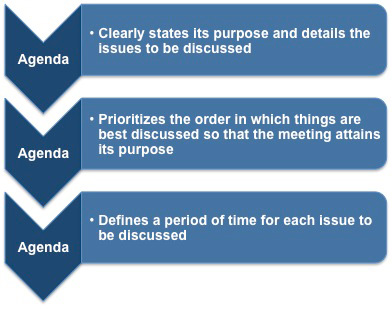 |
An agenda is usually defined as 'a list of items of business to be considered and discussed at a meeting.' Whilst this definition is technically true it obscures the fact that agendas actually serve a variety of purposes and are not just lists of things to discuss.
The Purpose of an Agenda
Your agenda should be more than just a list of discussion items to those you send it to. It performs five separate functions:
- Allowing invitees to decide whether or not they need to attend.
- Acting as a reference so that attendees can prepare for the meeting.
- Providing a structure for the meeting.
- Giving the Chair a tool they can use to keep the meeting under control.
- Representing a standard by which the meeting can be judged a success or failure.
Each of these has implications for organizational efficiency and for maintaining good relations with your co-workers and team members, as well as achieving the objective of the meeting.
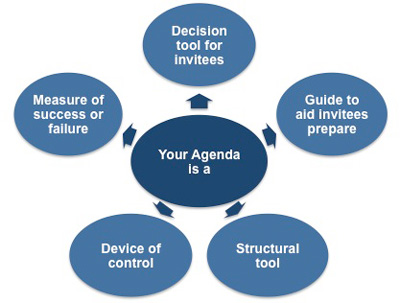 |
Decision Tool for Invitees
This is a function of an agenda that is frequently overlooked and is key to ensuring that you have the right people coming to the meeting. With the 'right' attendees you can achieve meaningful discussions, with everyone present making a valuable contribution and the meeting objective being attained.
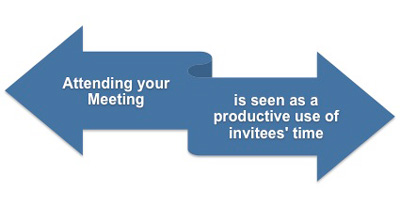 |
One of the main reasons why people have negative feelings about meetings is that they resent being made to sit through them unnecessarily. Many technical people resent spending time in meetings as their contributions are often confined to some technical or factual input, which could just as easily be delivered by an essential attendee who they can brief.
Others may feel that their input adds little or no value to what is already being contributed so feel frustrated at attending when their time could be more productively spent elsewhere. It is not always easy for you to discern whether someone should simply send their recommendations to the meeting or attend in person. You need to ensure that all invitees feel that their contribution is respected whether they attend or not.
Your best solution to this type of problem is to send a copy of the agenda asking attendees if they would prefer to attend the meeting or make their recommendation in some other way. You need to ensure that your key decision-makers recognize the need for them to attend and contribute to the meeting otherwise you will not be able to attain your meeting objective.
There are a variety of ways in which someone can contribute to your meeting effectively without having to attend. An individual may feel that their personal contribution can be effectively delivered via an email to other attendees or by providing a single-page overview that summarizes the key points that can be distributed at your meeting.
They can also brief another invitee who can include the person's contribution as part of their discussions. Another option is to make a recommendation through their manager on the understanding that they will be available in person or on the phone if further clarification is needed.
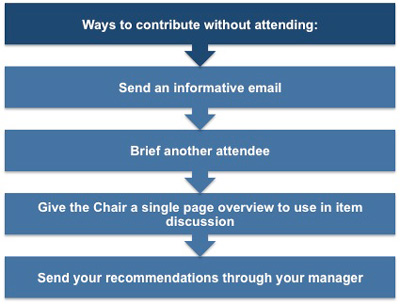 |
As a manager, you should do everything you can to protect your staff from being made to sit through meetings that they feel are a waste of time, as this will have a positive effect on morale and thus the productivity of your team.
A Guide to Aid Attendees to Prepare
Another function of the agenda is that by detailing what is to be discussed at the meeting, it encourages attendees to prepare properly for it. This preparation may involve simply taking along facts and figures or perhaps something more complex like preparing a short presentation or single-page summary.
In either case, the agenda positively encourages all of the attendees to prepare for the meeting properly. The timed allocations set aside for each item clearly indicates to attendees that they must have their arguments well thought through and prepared if they don't want to appear disorganized and unprofessional.
Your agenda needs to be sufficiently detailed and clear for people to be able to use it as a tool to prepare properly. It is important that any amends or additions to your agenda are communicated quickly to all attendees. A poorly put together agenda can lead to ill feeling if attendees feel that it has not given them sufficient information to prepare properly.
A political tactic sometimes used is to keep one or more attendees deliberately in the dark about some aspect of the meeting so that they can be outmaneuvered due to their lack of preparation and 'bounced' into agreeing to something that they would not otherwise have agreed to.
This tactic is highly unprofessional but can work well provided that the party doing the 'bouncing' is prepared to forego any future trust. That individual would have to live with the consequences of such an underhand approach, both for themselves and their organization.
Provides a Structure for the Meeting
Your agenda performs the vital role of keeping the meeting on track; it is extremely difficult to achieve this without one. Attendees often have their own views on what is important and these may be different to those of the organization as a whole or not conducive to the meeting's purpose.
When this is combined with the fact that some people simply like to talk, then it is not surprising that meetings can take up a lot of time and achieve very little in the absence of an agenda and a meeting chair who is prepared to enforce it.
An Aid to Controlling the Meeting
This point is subtly different to the previous one. Very often the Chair in a business meeting is at the same organizational level as the other attendees and cannot rely on his or her seniority to ensure that others comply. So the Chair will use the agenda as the device that ensures he or she has the control needed to keep the meeting flowing and to make decisions.
Without a timed agenda it can be difficult to stop determined attendees from hijacking the meeting to suit their own purposes. This is one reason why the agenda should specify the scope of each item as well as an allocated time for dealing with it. When this time limit has been reached, the Chair has control over the meeting's proceedings and has the power to draw the discussion to a close, summarizing actions and conclusions as required.
If you wish to retain control of your meetings then it is highly recommended that you never have 'Any Other Business,' commonly referred to as 'AOB,' at the end of your agenda. This single item is the most disruptive and destructive thing that can happen to your meeting. 'AOB' gives anyone the opportunity to hijack your meeting and destroy all that you have achieved up to this point, completely derailing your strict time control.
Some Chairs like to use this item as a way to control and focus discussions by using the line 'let's cover that under AOB.' Whilst this does prevent going off on a tangent during the meeting it only prolongs the diversion and will significantly extend the meeting beyond its timeframe!
Many attendees may have to leave the meeting on time due to other commitments so will leave before AOB discussions start, missing the key part of the meeting: the Chair's summary. If you have let this occur you have to ask yourself, has the meeting still been a success?
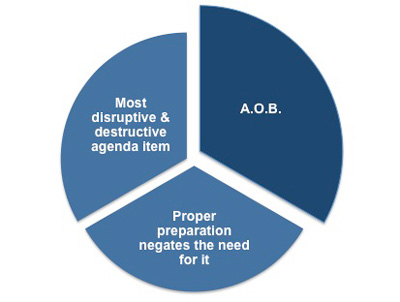 |
If you have prepared your agenda properly and from a knowledge-base you do not need to have such an item because all pertinent issues have been itemized and any issue outside the purpose of the meeting has been addressed by another meeting or in a more appropriate manner.
A Measure of Success or Failure
The creation of an agenda is not an exact science. You will need to use judgment based on experience in order to specify exactly what should be covered and how much time each item is likely to need to allow a full discussion. The extent of your own preparation into gaining information so that you have a thorough understanding of the purpose of the meeting will greatly assist you in this task.
If the meeting did not succeed in addressing every item on the agenda successfully then you should ask yourself if the agenda was too optimistic or the timeframe too short for a full discussion of all necessary facts. On the other hand, you may decide that more could have been covered and that decisions could have been made in less time than was allocated.
Your success may also be dependent on who the actual attendees were. If a key expert or decision-maker was absent then this could greatly hamper your ability to succeed.
You may also be interested in:
Writing a Meeting Agenda | Meeting Agenda Sample | Agendas for Short Meetings.



